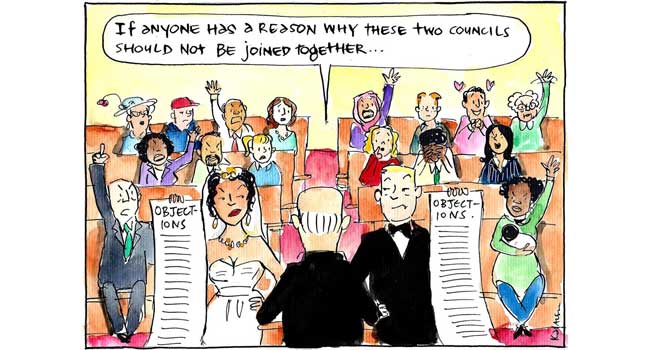
The spectre of amalgamations is looming closer for many NSW councils. On 16 October the Independent Pricing and Regulatory Tribunal (IPART) hands its hit-list to NSW Local Government Minister Paul Toole, detailing which councils it believes should merge and which can stand alone.
But councils have not been told when they will learn of their fate.
A spokesman for Mr Toole told Government News that the first stage was for IPART’s recommendations to go to the minister and then to cabinet. The recommendations would then be released to councils and to the public, but no date has been set.
Local Government NSW President Keith Rhoades said councils would probably discover their destinies “at the same time as Mr and Mrs Ordinary on the street.
“I’ve been advising councils that they need to go about their business on a daily and weekly basis as they’ve been doing for scores of years,” Mr Rhoades said.
He said there was “strong community resentment” to plans for forced mergers and that “the government had best heed what the majority of these communities are saying.”
“We are not part of the decision-making process,” Mr Rhoades said. “The government will make a decision eventually. You can’t speculate what’s going to happen. As far as I’m concerned, it’s business as usual. We have got services to provide that still need to be delivered and that needs to be the focus.”
Just a handful of NSW councils that have indicated they want to merge, but most have opposed the government’s scheme to reduce the state’s 152 councils by at least one-third. As local government authorities inch closer to learning their fate, council and community opposition to mergers has increased.
Strathfield Council will hold a no-amalgamation public rally against amalgamations on 10 October 10, Woollahra Council on 11 October and there is a public meeting in Ashfield on 22 October.
This week the Save Our Councils Coalition (SOCC) has demonstrated outside the electorate offices of Planning Minister Rob Stokes and Health Minister Jillian Skinner.
Meanwhile, in a mildly amusing political stunt, Greens MP David Shoebridge has been asking people to complete an online survey, which poses the question: “is Minister Toole fit for the future”?
The survey mirrors Mr Toole’s methodology for assessing councils under the government’s Fit for the Future strategy and includes questions such as:
“Does the Minister have sufficient scale and capacity to undertake the job of Local Government Minister?” and “Does the Minister have the resources to cope with complex and unexpected change?”
As well, the NSW Parliamentary inquiry into the NSW government’s Fit for the Future agenda will go public with its report on 30 October.
Pressure to hold an inquiry came after widespread community frustration that NSW Premier Mike Baird had refused to rule out forced amalgamations. There was also criticism from some quarters that Mr Baird had failed to prove or communicate the benefits of mergers to councils or to the general public.
Government News spoke to Christian Democrat Paul Green, who is chairing the inquiry, about the progress of the inquiry and the report’s initial findings.
“I don’t think the evidence given has been as strong towards forcing amalgamations,” Mr Green said. “There’s probably more identification that resource sharing could play a greater part.”
Mr Green said strong evidence had been presented to the inquiry for greater co-operation under joint organisations, but he did not feel that a case for the benefits of mergers had been adequately made.
He said the report, though not yet finalised, was likely to echo similar concerns to those arising in the December 2003 NSW Parliamentary Inquiry’s report on local government amalgamations. The 2003 Committee Chair, Ian Cohen, said at the time:
“Our consultations reveal that people expect to have a say in decisions about their local community, including the structure of their local government body. Threatening to amalgamate councils, when everyone knows that the problems go beyond boundary changes, does not sit well with many citizens,” Mr Cohen said.
“The Committee was persuaded that amalgamations do not necessarily lead to greater efficiencies and economies of scale. Neither academic experts, bureaucrats nor those councils who had experienced amalgamations could demonstrate that there was an economic benefit to amalgamations,” said the 2003 report.
Mr Green said the report was likely to reflect major issues NSW local councils still faced, such as cost-shifting and rate-pegging because little had changed. Asked if the timing of the report, two week’s after IPART handed down its findings was problematic, Mr Green said it was done on purpose.
“It’s actually strategic. We were hoping to have IPART’s work before we finalised the report to take all the evidence into consideration,” he said.





Leave a Reply